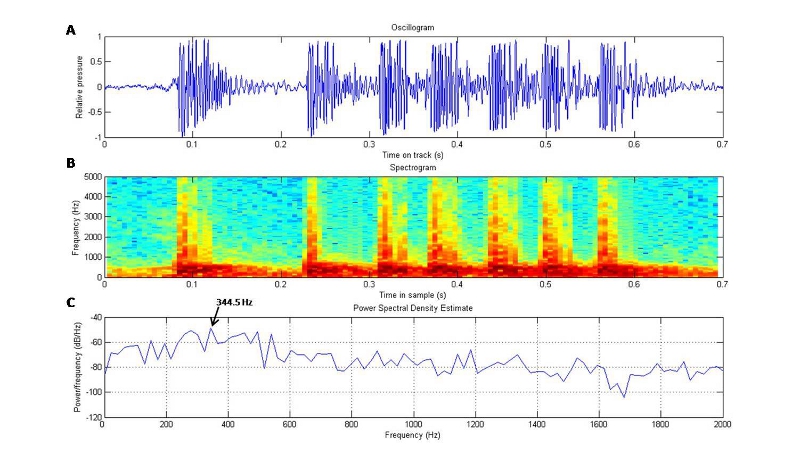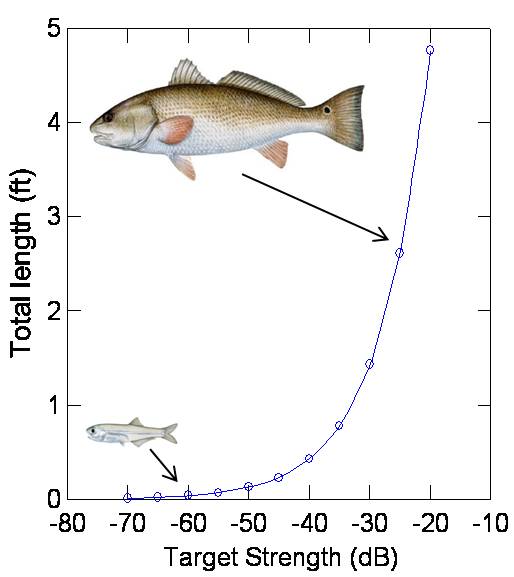Are Passive Acoustics an Appropriate Method to
Accurately Represent a Soniferous Atlantic Croaker (Micropogonias undulatus)
Population?
Cecilia S. Krahforst - csk1021@ecu.edu
Department
of Biology/Coastal Resource Management Doctoral Program
East
Carolina University
Greenville,
NC 27858
Joseph
J. Luczkovich
Department
of Biology/Institute for Coastal Science and Policy
East
Carolina University
Greenville,
NC 27858
Mark
W. Sprague
Department
of Physics
East
Carolina University
Greenville,
NC 27858
J.P.
Walsh
Department
of Geological Sciences/ Institute of Coastal Science and Policy
East
Carolina University
Greenville,
NC 27858
Charles
Singhas
Department
of Biology
East
Carolina University
Greenville,
NC 27858
Popular version of paper 2pAB8
Presented Tuesday afternoon, April 20, 2010
159th ASA Meeting, Baltimore, MD
Atlantic croaker (Figure 1) belongs to the commercially and recreationally important family of fishes called the Sciaenidae (sea trout, drums and croakers). Members of this family produce low-frequency (350-1000 Hz) sounds for communication: as an alarm response, during aggressive encounters, and to aid in reproduction. We ask whether these communicative sounds (click
here to listen to an Atlantic croaker sound) can be used to understand the population size distribution without physically catching the fish with nets or other size-selective gear.
Underwater digital audio recorders were deployed at two sites within Pamlico Sound from June to November 2008 to record 10 seconds of environmental sounds every 15 minutes (passive acoustic method). The fish community at each site was sampled once a month using trawls and gillnets (traditional fishery method). In addition, an echosounder (active acoustic method), which uses short high-frequency (200-kHz) pings and echoes to count fish and measure fish size, was simultaneously deployed with each trawl in order to determine the limitations of the trawl in capturing the fish size distribution.
All Atlantic croaker collected in the trawls were transported to a holding facility to develop a relationship between croaker sound frequency and fish size. Atlantic croaker were allowed a minimum of 24 hours to acclimate before collecting passive acoustic recordings in the laboratory. They were individually recorded for a minimum of 60 seconds, euthanized, weighed and measured. Individual pulses of the Atlantic croaker sound obtained from fish of different lengths were analyzed for fundamental frequency (Figure 2). A linear regression analysis was derived from these data, indicating that total length (TL, in mm) was inversely related to fundamental frequency (Fo, in Hz): TL = 305.32 (0.27*Fo) (R2=0.84). This equation was used to estimate the lengths of Atlantic croaker recorded in the field on the digital audio recorders from their fundamental frequency.
Analysis of sound recordings from the field sites indicated that Atlantic croaker collected in the trawls were significantly smaller (P<0.0001) than the estimate derived from the passive acoustic recording method. But, which method provided the true mean size of Atlantic croaker, trawl or passive acoustics? To answer this, we used active echosounder data. Data from the echosounder were analyzed and split into size categories based on target strength, which is the size of each echo-return. Echosounders do not produce species-specific echoes, so all species present in the acoustic beam below the vessel with high acoustic reflectivity (i.e., fish with gas-filled swim bladders) are included in these analyses. A stronger echo is obtained when a large fish is under the acoustic beam of the echosounder than when a small fish is in the beam at the same depth and in the same orientation (Figure 3). Analysis software accounts for depth variation using a method known as time varied gain. Basically, this method takes into account the time it takes for an echo to return to the receiver and modifies the echo accordingly (this is a standard fish echosounder analysis SONAR technique). These target strengths were then converted into total length categories based on Loves equation, an empirical relationship between target strength and total length of the fish producing the echo; this is another standard method in fish echo target strength analysis.
We next compared the average size of all fish species measured with the echosounder with the length estimates from fish collected using the trawls and gillnets. The average echosounder length estimates and average trawl length estimates differed (P<0.0001), as well as the gillnet length estimates (P=0.03). However, when length data from both types of nets were combined to create an average size of all species of fish present in the area, there was no significant difference between the length estimates based on nets and the echosounder (P=0.25). We concluded that the echosounder accurately represented fish lengths of all species in the community. Since this analysis considered all fish species, we limited the echosounder size estimates to targets with total lengths in the Atlantic croaker size range. The length distribution of fishes collected in the echosounder analysis was truncated to represent the lengths of Atlantic croaker that could have been collected, based on analysis of the recordings made by the passive acoustic recording device.
The final step was to compare mean Atlantic croaker length estimates from the passive acoustic data, the truncated echosounder data, and the net data. Because the gillnet did not catch any Atlantic croaker, we dropped it from further analysis. After truncating the target strength data to the range in which Atlantic croaker were likely to be present, the average length of Atlantic croaker caught in the trawl was less than those in the echosounder (P=0.007). These data suggest that the trawl selects fishes of a smaller size and actually underestimates the mean length of Atlantic croaker. We conclude that passive acoustic recorders provide a more accurate estimate the mean length of the Atlantic croaker population. These recorders are able to continuously monitor the Atlantic croaker population. We recommend that passive acoustic methods be used on ocean observatories to obtain a non-destructive estimate and rate of change of the Atlantic croaker population length distribution. This method should also be developed for other soniferous fish species such as other drumfish, codfish, and sea basses.

Figure 1. Photograph of an Atlantic Croaker (photograph courtesy of: M. Chad Smith)

Figure 2. Acoustic signature of Atlantic croaker #71, which is a 211 mm total length fish. A) Shows an oscillogram of a 0.7s acoustic response. Note that there are a total of 7 pulses within this acoustic response. B) A spectrogram of the same fish; indicating that the majority of the energy lies below 1000 Hz. C) Interpretation of the fundamental frequency of the acoustic signature produced by second pulse observed on the oscillogram and spectrogram. The peak power occurs at 344.5 Hz

Figure 3. The relationship between target strength and total length using Loves (1977) equation. A smaller fish (e.g. Bay Anchovy) has a more negative target strength than that of a larger fish (e.g. Red Drum).


